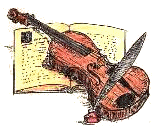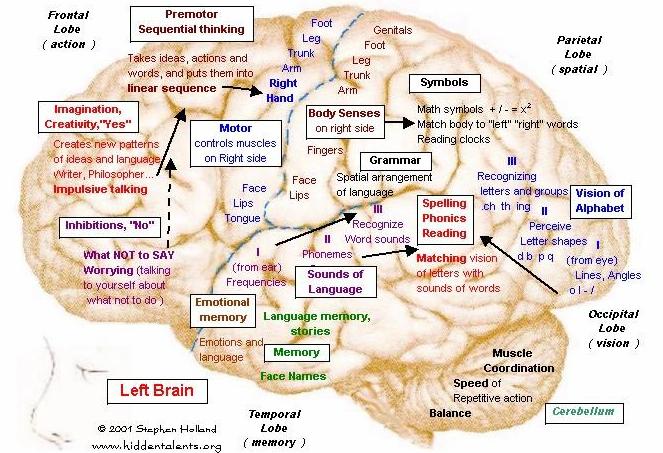
Hidden Talents and Brain Maps
Hiddentalents.org
© 2001 Stephen Holland --- sholland@softwaves.net
| 11 Right | sources |
 Hidden Talents and Brain Maps Hiddentalents.org © 2001 Stephen Holland --- sholland@softwaves.net
|
Home | Index | Outer parts | |||||
| Input / Output | Inner parts | |||||||
| L / R Sides | Patchwork Quilt | |||||||
| Brain Maps | Print maps | |||||||
| LEFT Brain | RIGHT Brain | |||||||
| Activities | L / R Types | |||||||
| Balanced vs Expert | Men vs Women | |||||||
| Feedback | Sources | |||||||
|
|
||||||||
| 12. Talents in the Left Brain |

The Left "Human" brain The right brain is the "animal brain" and analyzes the environment for the sights and sounds useful for survival. In essence, animals are almost 100% "right-brained." Humans have kept the animal talents on the right side, but have modified the left brain for language and tool use. The following is a summary of talents found in the left brain. Each talent is a complex network of different processes beyond what is mentioned here, but injuries or strokes in these areas would result in serious loss of these specific talents. Language Sounds Sound input in the human left brain is specialized for discriminating the sounds of language. As children grow in the first few months, their sound patch in the temporal lobe is hearing the sounds of people talking, and remembering that certain sound patterns seem to always match certain objects and actions.  Animals do have a limited symbolic vocabulary,
and can communicate concepts with certain
sounds. The song sparrow in the tree near
our house sings a very definite song, which
other song sparrows, out of sight, can translate as meaning that he is claiming territory. This is definitely using a specific sound
as a symbol to communicate a real world concept.
In contrast, a dog growling and baring its
fangs is not being very subtle or symbolic. Animals do have a limited symbolic vocabulary,
and can communicate concepts with certain
sounds. The song sparrow in the tree near
our house sings a very definite song, which
other song sparrows, out of sight, can translate as meaning that he is claiming territory. This is definitely using a specific sound
as a symbol to communicate a real world concept.
In contrast, a dog growling and baring its
fangs is not being very subtle or symbolic.(Click here for a song sparrow territorial call -- 92 kb .wav file.) Humans can make very fine distinctions in sound, and therefore meaning. For example we can distinguish the difference in sound of "sat" and "sad." Instead of one bird song meaning "territory," we have pages of words on a real estate contract. (If complexity of vocabulary and grammar is a measure of human evolution, then this implies that, on the average, left-brained women who talk a lot are more "human" than most men who do more grunting, and lawyers, poets, and talk-show hosts may represent more evolutionarily advanced, human careers.)  Books give children exposure to much more
complex vocabulary, and proper grammar, than children will ever hear from oral language
in normal family or school life. This is
especially true if parents read to the children, which gives young children access to language
and ideas years ahead of their own reading
ability. Read, read, read!!!! Books give children exposure to much more
complex vocabulary, and proper grammar, than children will ever hear from oral language
in normal family or school life. This is
especially true if parents read to the children, which gives young children access to language
and ideas years ahead of their own reading
ability. Read, read, read!!!!Vision and Reading  ision in the human left brain is specialized
for reading. The left brain learns to see
arrangements of lines we call alphabet letters. ision in the human left brain is specialized
for reading. The left brain learns to see
arrangements of lines we call alphabet letters.For example...
Phonics and Spelling We think in the sounds of a language -- and can even think with a foreign accent. Reading is merely a visual gimmick tacked onto our oral vocabulary and grammar. It is common to have people who can speak but not read; it is impossible to have a person who can read but not understand the same language when spoken. Children at age 6 years have a good oral vocabulary and grammar. Also, their visual cortex has usually developed enough to distinguish the visual shapes of letters. Now they are ready for reading. There is a special part of the cortex, called the "angular gyrus" which has evolved to match sounds with letters. (A "gyrus" is simply a fold in the cortex that bulges up, while a "sulcus" is a valley.) This is the area so important for spelling.
 The angular gyrus develops from about age 6 to 9, then it is mostly finished for most people.
Done. If children are exposed to good phonics training
in the Primary grades, they will tend to
be much better at spelling and reading. For example, the term "word attack skills" means using phonics to sound out letters
until they trigger a match with the sound
of a word already in the brain. The angular gyrus develops from about age 6 to 9, then it is mostly finished for most people.
Done. If children are exposed to good phonics training
in the Primary grades, they will tend to
be much better at spelling and reading. For example, the term "word attack skills" means using phonics to sound out letters
until they trigger a match with the sound
of a word already in the brain. Reading is a code for oral language, and phonics (The "whole language" fad that ignored phonics was popular in education in the 1970s and 80s, and resulted in a wave of poor spellers and readers going through the school system. I earned money tutoring them.) Grammar Grammar is the spatial sense of vocabulary. This is especially true of English, which developed a relatively simple grammar system that depends upon spatial order much more than endings or gender. In English, we have grammar in our left brain that knows "Boy chases kangaroo" is different than "Kangoroo chases boy." We could also draw pictures in our right brain to symbolically say the same thing: Left brain words = Right brain images =      As a child grows, the brain soaks in whatever sounds it hears which we call vocabulary and grammar. After age 10, the vocabulary and grammar parts of the brain are mostly finished growing, and the thinking parts of the brain in the frontal lobe continues growing, building upon the foundation of grammar and vocabulary learned in childhood. See --- Learning Foreign Languages Body Senses Body senses, such as touch, pain and limb position, are similar to the right brain, except that the left brain senses the right side of the body. However, in the left brain they are important for some forms of symbolic thinking (next section). Symbolic Relationships The spatial area of the brain, in the parietal lobe, senses complex arrangements. In the left brain, this area works with symbols, not just visual shapes. Examples include... Right / Left. The body senses tell a child which foot the mother is touching. Vision shows which foot the mother is pointing to. Now the mother says the words, "Put on your left shoe." Eventually the child's brain matches up the word "left" with a certain side of the body. More advanced learning will allow the child to match the word "left" with map symbols and the world of navigation so he can say "According to the map, we should make a left turn." This matches lines on a map with the left side of his body. My wife had an interesting experience while teaching Kodaly music to children. She taught herself to use the left hand when she said "right" so the young children could mimic her, but afterwards she often got left and right instructions wrong, "Turn left -- no, I mean right."  Reading Clocks. The parietal lobe matches up the sense
of time with symbols of a clock face. I once
had an intelligent grade 10 student who could
not read a traditional clock because he had
always used a digital clock as a child. Reading Clocks. The parietal lobe matches up the sense
of time with symbols of a clock face. I once
had an intelligent grade 10 student who could
not read a traditional clock because he had
always used a digital clock as a child. Math involves a variety of talents. A concept such as "add" must involve a child seeing the difference between one and two cookies on a plate. The parietal lobes on both sides of the brain work together on math. However, the left brain will tend to work harder on algebra (which is a lot like language grammar), while the right brain will do most of the geometry work. Mental arithmetic is strongly in the right brain because symbols must be moved around in a visual-spatial way. Creative Ideas The creative area of the left frontal lobe rearranges words, concepts, symbols, and memories into new patterns. In effect, this allows us to think up new things to say.  When we think about something, we are usually
using oral language in our mind. We can rehearse a speech, dream of a conversation,
imagine a poem, and remember what someone
said on the phone. We can even think with
a foreign accent. Most of this goes on in
the frontal lobe above our eyebrows. When we think about something, we are usually
using oral language in our mind. We can rehearse a speech, dream of a conversation,
imagine a poem, and remember what someone
said on the phone. We can even think with
a foreign accent. Most of this goes on in
the frontal lobe above our eyebrows.   Clues that this area is well-developed are indicated if a person is... Clues that this area is well-developed are indicated if a person is...
Inhibitions and Worry The lower frontal lobe, above the eyes, has the job of stopping a person from getting into trouble through wrong actions. On the left side this means not saying the wrong thing at the wrong time. Because most of our thnking is oral language, this area is important for "talking to ourself" and worry.  If the area is too strong, then a person may worry so much that they are afraid to do or say anything. Shyness is a survival mechanism for avoiding trouble. The Premotor area The Left premotor area, in upper left front of the forehead, keeps track of sequential patterns -- words, symbols, ideas, that come one after another. This is highly important for humans with symbolic thinking. The area primarily would have evolved for planning tool use -- how to use tools in a sequential way to accomplish symbolic goal. Because the motor nerves cross, this left-brain premotor area controls the RIGHT HAND. Humans are "handed" because one side of the brain specialized to do sequential operations. Most humans have symbolic language in the left brain, so most humans are Right-Handed! Key talents where this area is important include:
The Motor area In the Left-brain, this area puts into practice the instructions from the left-brain pre-motor area, but controlling the Right Side of the body. This of course covers the Right hand. Because the Left side of the brain is language based, the Motor area also controls strongly the instructions to speak language. (Stuttering may involve confusion between the left and right Motor and Pre-Motor areas trying to control the single language ability.) The Speech area This seems to be a highly developed part of the general motor area, which evolved to handle the difficult muscle control needed for speech creation. |
 Custom Search
Custom Search